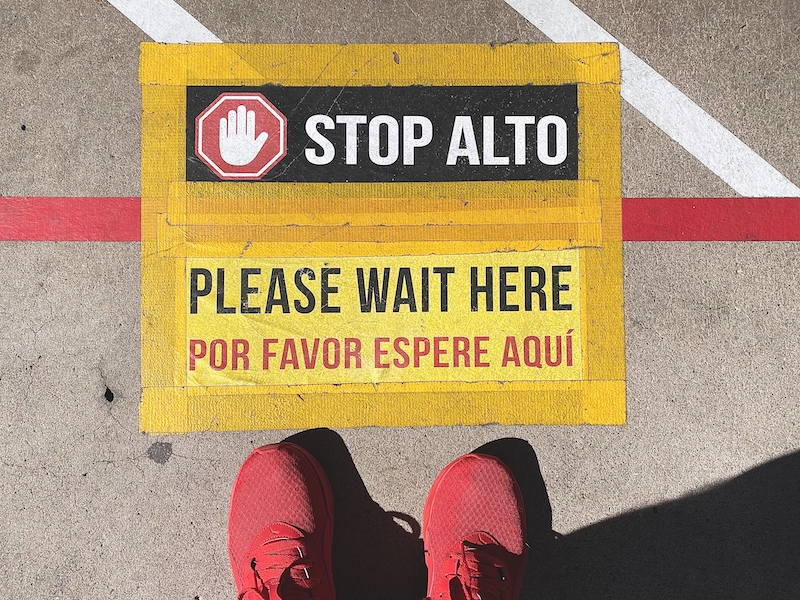Do you know how to say “stop” in Spanish? You might be familiar with the word para or have seen a red stop sign in a Spanish-speaking country with the word alto printed on it. Today, you’ll explore the various other ways to express “stop” in Spanish.
Whether you intend to use it as a verb in a sentence or as an interjection, we’ll guide you on choosing the appropriate word based on the context or situation.

Para
Para is commonly used to command someone to stop an action. It originates from the verb parar, which translates to “to stop” in English. The word is imperative, indicating a direct order.
In its imperative form, you use para for informal tú commands and pare for formal usted commands. When addressing a group, you would say paren.
When parar functions as a regular verb, it follows the typical conjugation patterns of -ar verbs.
- iPara de comer! = Stop eating! (imperative)
- Mi amigo paró de hacer ejercicio. = My friend stopped exercising. (past tense verb)
Para de hablar. Ya no te quiero escuchar.
Stop talking. I don’t want to listen to you anymore.
Alto
Alto is equivalent to the English “stop” used for traffic signs. It functions as an authoritative interjection commanding someone to halt. It is also a masculine noun, referred to as el alto.
As an imperative, alto serves as a commanding warning. For this reason, it is used by police officers, military personnel, and security officials to order individuals to stop. However, you can also use it yourself to instruct or warn someone to come to a halt.
Example usage:
- ¡Alto! ¡Sube las manos! = Stop! Raise your hands! (imperative)
- Se te pasó el alto. = You missed the stop. (noun)
- Para en el alto. = Stop at the stop sign. (imperative and noun)
Since alto is an interjection, it often stands alone in a sentence or makes up a short phrase. For example:
¡Alto ahí!
Stop there!

Alto also means tall or high in Spanish. We can guess the meaning of the word by understanding the context of the sentence. Example:
- El hombre es muy alto. (The man is tall.)
- El Burj Khalifa es increíblemente alto. (The Burj Khalifa is incredibly high.)

Detente
Detente comes from the verb detener, which means to halt someone or something. It is an order or command.
It’s not used much in casual conversations because it’s more formal and carries a sense of urgency. As a command, it’s used similarly to alto. You use it when you want someone to be safe or when you demand they stop.
- ¡Detente ahora mismo! = Stop right now!
- Detente en el alto. = Stop at the stop. / Stop at the stop sign.
¡Detente, viene un carro!
Stop! A car is coming!
Deja de…
Deja comes from the verb dejar which means different things in Spanish such as to leave, to let, to leave behind, and to leave someone or something.
In this case, we are looking at the meaning to stop doing (verb). Some examples include Stop talking! Deja de hablar! and Stop eating! Deja de comer!
Deja de comer tanto dulce. Te hace daño.
Stop eating so much candy. It’s not good for you.

Suspender
Suspender in English means to suspend. This word is used in more formal or official contexts, such as suspending activities or services. For example, Suspendieron la reunión debido a la advertencia de huracán. (They stopped the meeting because of the hurricane warning.) This verb is used when something is being temporarily stopped or postponed.
The same sentence above could be used with the past tense of the verb detener. It would be, Detuvieron la reunión debido a la advertencia de huracán.
Suspendieron las clases debido al mal tiempo.
Classes were suspended due to bad weather.
Cesar
Cesar is the verb to cease in English. It’s typically used in formal contexts and commonly denotes the cessation of an activity, action, or process. For instance, it can refer to the end of a noise or storm. Another usage includes the conclusion of a contract or employment position.
This word is more commonly used as a regular verb rather than an imperative. Therefore it can be conjugated like a regular Spanish -ar verb.
- Los militares cesaron el fuego. = The military ceased fire.
La tormenta finalmente cesó.
The storm finally ceased.

Impedir
The word impedir in English means to impede, prevent, or stop. This way of saying stop is more related to the idea of preventing something from happening. It requires an active action from the main subject to stop or prevent an event or action from occurring.
It follows regular Spanish -ir verb conjugation patterns. For example,Voy a impedir su boda porque él no la quiere. (I’m going to prevent/stop his wedding because he doesn’t love her.)
Mi hermana quiere impedir que me vaya a vivir a Colombia.
My sister wants to stop me from going to live in Colombia.
Basta
An informal way to ask someone to stop is basta, which means enough. Although it doesn’t directly translate to “stop” in Spanish, it’s used to demand an action, situation, or behaviour to cease. For instance, in an argument between two people, if you want the other person to stop arguing, you can say ¡Basta! or ¡Ya basta! (stop now).
Basta con las excusas.
Enough with the excuses.
Suficiente
Suficiente is used similarly to basta and also means enough. This adverb can also mean sufficient and is used informally as an interjection to tell someone to stop their actions. For example, a mother can tell her children to stop arguing by saying:
¡Eso es suficiente!
That’s enough!

Frena
Frena is used to tell someone to stop in Spanish. While its English translation is brake, referring to what you use when driving, in Spanish the word can also mean to stop walking or talking. For example:
Frena, escuché un ruido que viene de los árboles.
Stop, I heard a noise coming from the trees.
No sigas
No sigas means don’t continue in English. In Spanish, it’s commonly used to tell someone to stop talking or arguing. It’s similar to saying ya para or ya basta, which means stop now. An example of how it could be used is: No sigas discutiendo con ella, which means Stop arguing with her or Don’t continue arguing with her.
No sigas hablando mal de tu amiga.
Stop badmouthing your friend.

